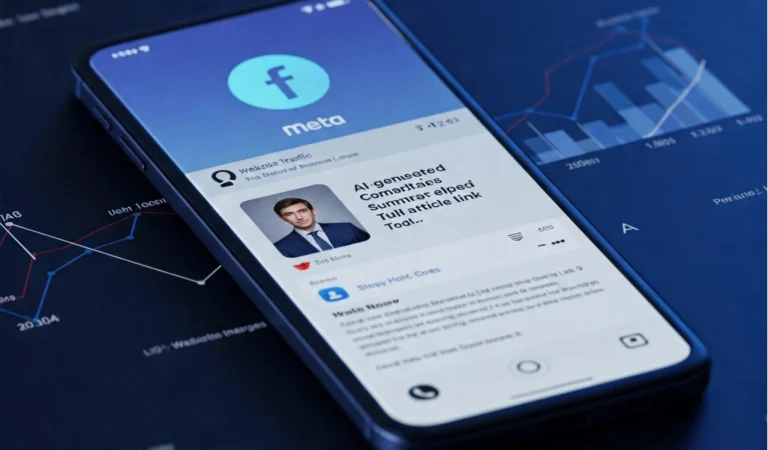In 2025, the way people browse social media and discover content is undergoing a massive transformation — and Meta (formerly Facebook) is leading the charge. With the introduction of Meta AI Summaries, users no longer need to click away from Facebook or Instagram to get the gist of an article. This AI-generated feature presents brief, digestible versions of external content right inside their feed.
At first glance, it feels convenient. But for publishers, bloggers, and digital marketers, it’s a wake-up call: What happens when social media stops sending traffic to websites? Let’s break down what Meta AI Summaries are, how they work, and the very real impact they’re already having on web traffic.
What Are Meta AI Summaries?
Meta AI Summaries are short, machine-generated summaries that appear when users see a link shared on Facebook or Instagram. Instead of clicking the link to read a full article on a publisher’s website, users now see an AI-created TL;DR (too long; didn’t read) version right in their feed.
Example Scenario:
You share a news article from CNN. Instead of driving traffic to CNN’s website, Meta shows a 3-sentence summary under the link preview, generated by its Llama-powered language model. The user gets the takeaway instantly — no click required.
Why Did Meta Introduce This Feature?
Meta claims this update helps users save time and make informed decisions faster. According to Meta:
- People are overwhelmed by clickbait and misleading headlines.
- Summaries reduce misinformation by giving context.
- AI helps personalize what users actually care about.
But let’s be honest — Meta also benefits by keeping users on-platform longer, rather than sending them away to read full articles elsewhere. This aligns with a bigger trend across tech giants: building “walled gardens” that don’t easily let users out.
The Impact on Social Media Traffic to Websites
Let’s talk numbers. Since the rollout of Meta AI Summaries in late 2024, many websites in the U.S. have reported a 10–30% drop in referral traffic from Facebook and Instagram.
Here’s why:
- Less Clicking: Users read the summary and feel satisfied. No need to click through.
- Lower Engagement with Links: The AI content is prioritized in the feed, not the actual link.
- Algorithmic Preference: Facebook’s AI now often promotes its own summary layer over the original post’s text or preview.
This hits content publishers where it hurts — traffic, ad revenue, and visibility.
Which Industries Are Affected the Most?
Some content categories are more affected than others. Here’s a breakdown:
Hardest Hit:
- News & Media Outlets – Summaries eliminate the need to read full articles.
- Bloggers & Writers – Lower click-throughs mean less exposure and income.
- Affiliate Marketers – Fewer site visits = fewer conversions and commissions.
Less Affected (for now):
- E-commerce & Product Pages – Users still need to click to shop or buy.
- Interactive Content (e.g., quizzes, tools) – Hard to summarize; requires engagement.
- Video Creators – Meta is pushing Reels and native videos instead.
What About SEO and Google Ranking?
Ironically, as Meta sends less traffic, some publishers are noticing more traffic from Google Discover, Search, and even Bing Chat. Why? Because as AI summaries increase on social, people search elsewhere for deeper information.
To capitalize on this shift:
- Make sure your content is well-structured for Google snippets.
- Use FAQs and schema markup to help search engines “see” your content clearly.
- Optimize for long-tail keywords that answer specific questions AI summaries skip.
How Should Publishers Adapt in 2025?
Meta’s AI summaries aren’t going away — they’re expanding. Here’s what publishers, bloggers, and creators can do:
✅ 1. Write Smarter Headlines
If your headline is weak, Meta’s summary becomes the hero. But if your title teases something intriguing, readers are more likely to click for the full story.
Tip: Use curiosity-driven headlines like:
“You Won’t Believe What the Data Actually Says” or
“This One Statistic Changed How I View AI in Healthcare”
✅ 2. Use In-Post Calls to Action (CTAs)
Even if a user reads a summary, a well-placed CTA can encourage them to visit the full article.
Example:
“Read the full breakdown with expert quotes, charts, and case studies here →”
✅ 3. Offer Exclusive Content on Your Site
AI summaries can’t replicate downloadable PDFs, exclusive videos, or tools. Add things to your post that can’t be summarized, like:
- Free checklists
- Interactive calculators
- Member-only downloads
✅ 4. Build an Email List — Fast
Social media traffic may drop, but your email list is immune to AI summaries. Offer something valuable (a free eBook, discount, or exclusive article) to get visitors to subscribe.
✅ 5. Use Meta Tags Strategically
Meta now scans Open Graph tags and in-post schema to generate summaries. If you’re not telling AI what to use, it will pick randomly.
Make sure:
- Your meta description is compelling
- You use structured headers (H2, H3)
- Your first paragraph is strong and clear
What’s Next? The Future of Social Traffic in the AI Era
Meta AI Summaries are just the beginning. Rumors suggest:
- Instagram Notes might soon include AI summaries for story links.
- Facebook Messenger could summarize shared links in chat.
- Threads by Meta is testing AI-generated news digests based on your reading habits.
It’s not hard to imagine a future where social media replaces your newsreader, blog reader, and browser — all powered by AI.
So what should you do?
Diversify. Don’t rely solely on Facebook or Instagram for website traffic. Focus on:
- Google SEO
- YouTube or TikTok SEO
- Direct visits and email marketing
The creators and brands who adapt early will survive the shift — the rest will see their traffic dry up.
Final Thoughts: Embrace the Change, Don’t Fear It
Yes, Meta AI Summaries are changing the game. But this isn’t the end of web traffic — it’s just the next evolution. Social media platforms are adapting to user behavior, and so must we.
By writing better content, optimizing smarter, and delivering real value beyond what an AI can summarize, your brand can still thrive in this new era of content discovery.
Summary Checklist: How to Prepare for Meta AI Summaries
✅ Optimize headlines for clicks
✅ Add irresistible CTAs inside your post
✅ Offer exclusive content on your site
✅ Build and nurture your email list
✅ Use correct meta and Open Graph tags
✅ Focus on long-form, value-rich content
✅ Diversify traffic sources beyond social media


